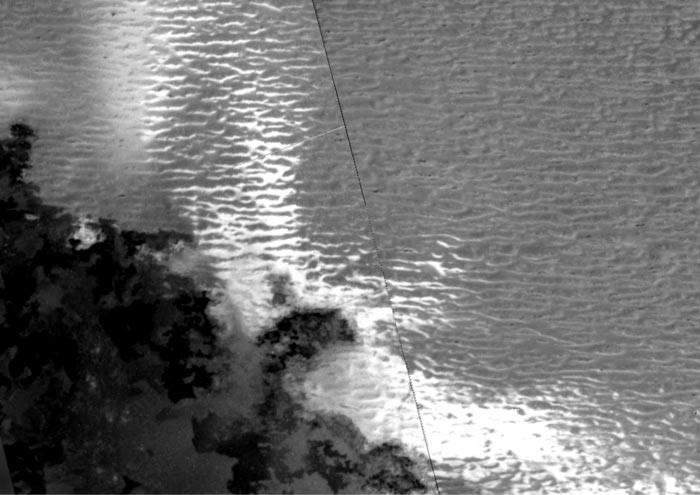Jupiter’s moon has splendid dunes

Potential dunes on Jupiter’s moon Io. An analysis indicates that the dark material (lower left) is recently emplaced lava flows, while the repeated, line-like features dominating the image are potential dunes. The bright, white areas may be newly emplaced grains as the lava flows vaporize adjacent frost.
Credit: NASA/JPL-Caltech/Rutgers
Rutgers study shows new way dunes can form on varied celestial surfaces.
Scientists have long wondered how Jupiter’s innermost moon, Io, has meandering ridges as grand as any that can be seen in movies like “Dune.” Now, a Rutgers research study has provided a new explanation of how dunes can form even on a surface as icy and roiling as Io’s.
The study, published in the journal Nature Communications, is based on a study of the physical processes controlling grain motion coupled with an analysis of images from the 14-year mission of NASA’s Galileo spacecraft, which allowed the creation of the first detailed maps of Jupiter’s moons. The new study is expected to expand our scientific understanding of the geological features on these planet-like worlds.
“Our studies point to the possibility of Io as a new ‘dune world,’” said first author George McDonald, a postdoctoral researcher in Rutgers’ Earth and Planetary Sciences Department. “We have proposed, and quantitatively tested, a mechanism by which sand grains can move, and in turn dunes could be forming there.”
Current scientific understanding dictates that dunes, by their nature, are hills or ridges of sand piled up by the wind. And scientists in previous studies of Io, while describing its surface as containing some dune-like features, concluded the ridges could not be dunes since the forces from winds on Io are weak due to the moon’s low-density atmosphere.
“This work tells us that the environments in which dunes are found are considerably more varied than the classical, endless desert landscapes on parts of Earth or on the fictional planet Arrakis in ‘Dune,’” McDonald said.
The Galileo mission, which lasted from 1989 – 2003, logged so many scientific firsts that researchers to this day are still studying the data it collected. One of the major insights gleaned from the data was the high extent of volcanic activity on Io – so much so that its volcanoes repeatedly and rapidly resurface the little world.
Io’s surface is a mix of black solidified lava flows and sand, flowing “effusive” lava streams, and “snows” of sulfur dioxide. The scientists used mathematical equations to simulate the forces on a single grain of basalt or frost and calculate its path. When lava flows into sulfur dioxide beneath the moon’s surface, its venting is “dense and fast moving enough to move grains on Io and possibly enable the formation of large-scale features like dunes,” McDonald said.
Once the researchers devised a mechanism by which the dunes could form, they looked to photos of Io’s surface taken by the Galileo spacecraft for more proof. The spacing of the crests and the height-to-width ratios they observed were consistent with trends for dunes seen on Earth and other planets.
“Work like this really allows us to understand how the cosmos works,” said Lujendra Ojha, a co-author and an assistant professor in the Department of Earth and Planetary Sciences. “In the end, in planetary science, that is what we are trying to do.”
The paper also included authors from the University of Oregon, the Massachusetts Institute of Technology, Texas A&M University and the Jet Propulsion Laboratory at the California Institute of Technology.
Journal: Nature Communications
DOI: 10.1038/s41467-022-29682-x
Article Title: Aeolian sediment transport on Io from lava–frost interactions
Article Publication Date: 19-Apr-2022#
Media Contact
Megan Schumann
Rutgers University
megan.schumann@rutgers.edu
Office: 848-445-1907
All latest news from the category: Physics and Astronomy
This area deals with the fundamental laws and building blocks of nature and how they interact, the properties and the behavior of matter, and research into space and time and their structures.
innovations-report provides in-depth reports and articles on subjects such as astrophysics, laser technologies, nuclear, quantum, particle and solid-state physics, nanotechnologies, planetary research and findings (Mars, Venus) and developments related to the Hubble Telescope.
Newest articles

Innovative 3D printed scaffolds offer new hope for bone healing
Researchers at the Institute for Bioengineering of Catalonia have developed novel 3D printed PLA-CaP scaffolds that promote blood vessel formation, ensuring better healing and regeneration of bone tissue. Bone is…

The surprising role of gut infection in Alzheimer’s disease
ASU- and Banner Alzheimer’s Institute-led study implicates link between a common virus and the disease, which travels from the gut to the brain and may be a target for antiviral…

Molecular gardening: New enzymes discovered for protein modification pruning
How deubiquitinases USP53 and USP54 cleave long polyubiquitin chains and how the former is linked to liver disease in children. Deubiquitinases (DUBs) are enzymes used by cells to trim protein…


